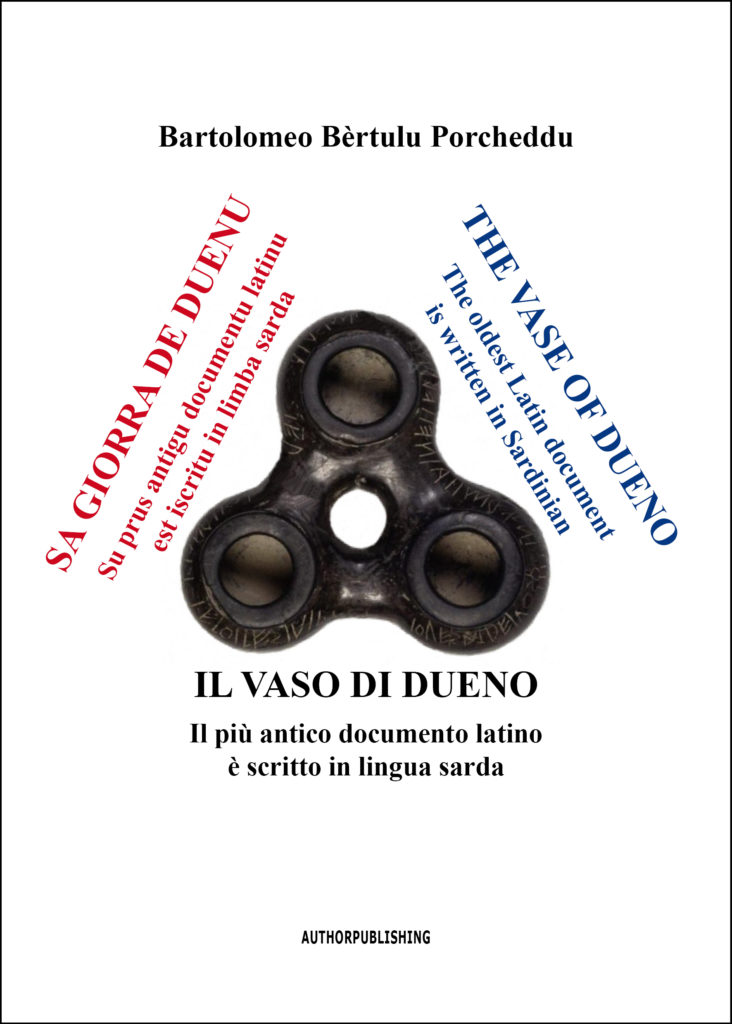Per acquistare il libro clicca qui in basso su PAGA ADESSO. Prezzo 15,00 Euro.

THE VASE OF DUENO
The oldest Latin document is written in Sardinian.
The Vase of Dueno is a talking object. First of all because it reproduces a “Trigon”, that is the conjunction between Jupiter and Saturn with respect to the sun and the earth that manifests itself in the night sky. When these two planets are at a distance of 120° on the celestial sphere, they draw an equilateral triangle just like the Vase of Dueno. In ancient times, this conjunction was considered a gift from heaven.
Secondly, the artifact also tells us who the Trigon is intended for. The Vase is a donation to Jupiter and Saturn, a request for a vote, so that a desire expressed by those who commissioned the work is realized. This is why the Vase of Dueno was found by Heinrich Dressel, in 1880, in a votive deposit at the Quirinale in Rome.
Finally, the client, who lived about 600 years before Christ, wanted to leave his thoughts written on the vase. The inscription is reported in the archaic Latin alphabet and is long enough to be considered the first Latin document. The most amazing thing is that this “promise to vote” is written in Sardinian without the Latin cases of Greek origin and can be read with relative simplicity even today.
The book is written in three languages (English, Sardinian, Italian) and is composed of 136 pages. Spedizione gratuita solo in Italia.
SA GIORRA DE DUENU
Su prus antigu documentu latinu est iscritu in sardu.
Sa Giorra de Duenu est unu trastu chi faveddat. In primu logu ca reprodughet unu “Trìgonu”, ossiat sa cungiuntzione intre Zove e Saturru respetu a su sole e a sa terra chi si manifestat in su chelu noturnu. Cando custos duos pianetas sunt atesiados de 120° subra su chircu tzeleste, disinnant unu triàngulu echilàteru pròpiu sìmile a sa Giorra de Duenu. In antighidade, tale congiuntzione fiat cussiderada unu donu de su chelu.
In segundu logu, su manufatu nos narat fintzas a chie est distinadu su Trìgonu. Sa Giorra est una donatzione a Zove e Saturru, una promissa de votu, a manera chi si realizet unu disìgiu isprimidu dae chie at cummissionadu s’òpera. Custu est su motivu pro chi sa Giorra de Duenu est istada agatada dae Heinrich Dressel, in su 1880, indunu depòsitu votivu peri su Chirinale in Roma.
Pro ùrtimu, su cummitente, bìvidu unos 600 annos in antis de Cristu, at chèrfidu lassare iscritu subra sa Giorra su pessamentu sou. S’iscritzione est reportada in alfabetu latinu arcàicu e est bastante longa de pòdere èssere cussiderada su primu documentu latinu. Sa cosa prus ispantosa est chi custa “promissa de votu” est iscrita in sardu chentza sos casos latinos de orìghine greca e podet èssere lèghida cunduna tzerta fatzilidade finas oje.
Su lìberu est iscritu in tres limbas (Inglesu, Sardu, Italianu) e est cumpostu de 136 pàginas. Ispedizione a s’indonu in Italia ebbia.
IL VASO DI DUENO
Il più antico documento latino è scritto in sardo.
Il Vaso di Dueno è un oggetto parlante. In primo luogo perché riproduce un “Trigono”, ovverosia la congiunzione tra Giove e Saturno rispetto al sole e alla terra che si manifesta nel cielo notturno. Quando questi due pianeti si trovano alla distanza di 120° sulla sfera celeste, disegnano un triangolo equilatero proprio simile al Vaso di Dueno. In antichità, tale congiunzione era considerata un dono del cielo.
In secondo luogo, il manufatto ci dice anche a chi è destinato il Trigono. Il Vaso è una donazione a Giove e Saturno, una richiesta di voto, perché si realizzi un desiderio espresso da chi ha commissionato l’opera. Questo è il motivo per cui il Vaso di Dueno è stato rinvenuto da Heinrich Dressel, nel 1880, in un deposito votivo presso il Quirinale a Roma.
Per ultimo, il committente, vissuto circa 600 anni prima di Cristo, ha voluto lasciare scritto sul vaso il proprio pensiero. L’iscrizione è riportata in alfabeto latino arcaico ed è abbastanza lunga da poter essere considerata il primo documento latino. La cosa più strabiliante è che questa “promessa di voto” è scritta in sardo senza i casi latini di origine greca e può essere letta con una relativa facilità ancora oggi.
Il libro è scritto in tre lingue (Inglese, Sardo, Italiano) ed è composto di 136 pagine. Spedizione gratuita solo in Italia.